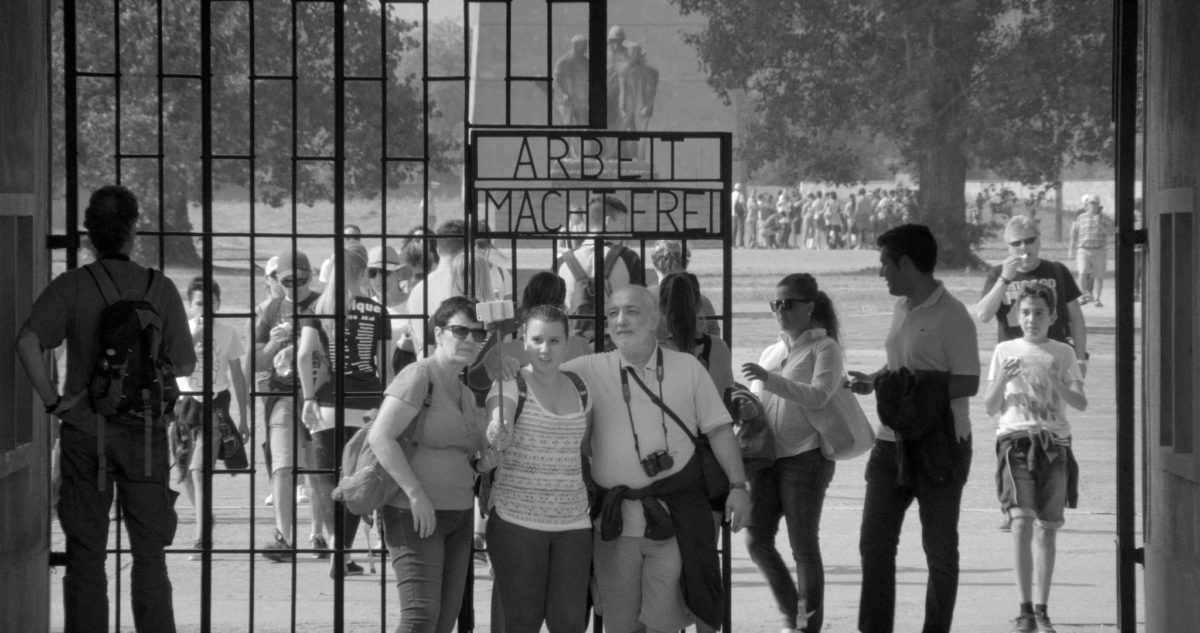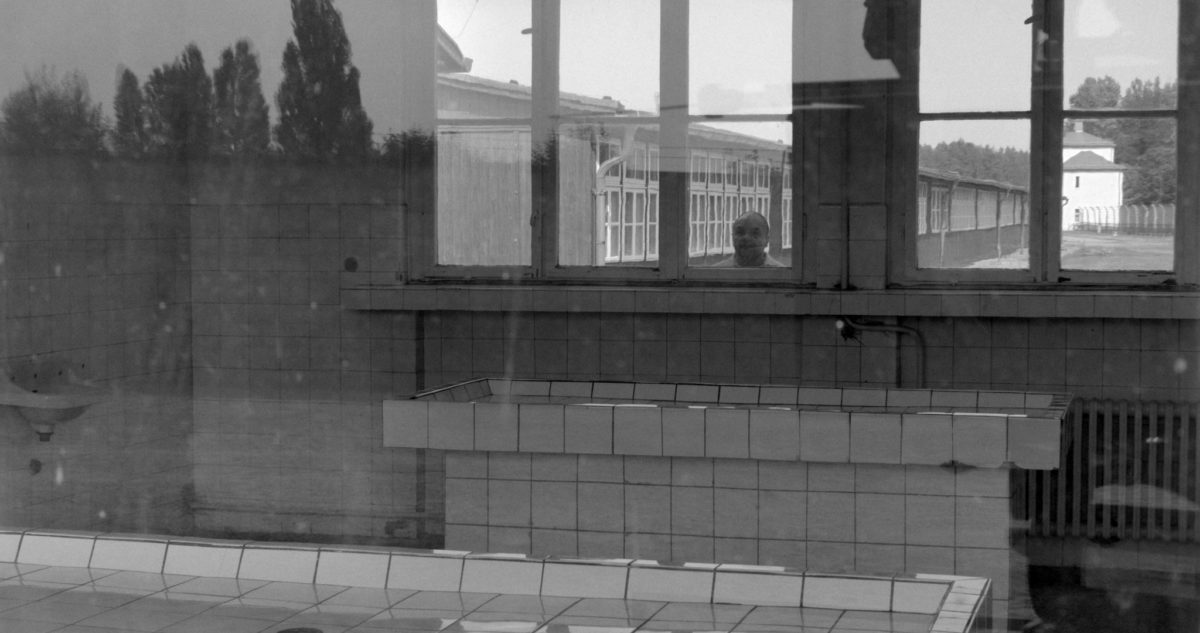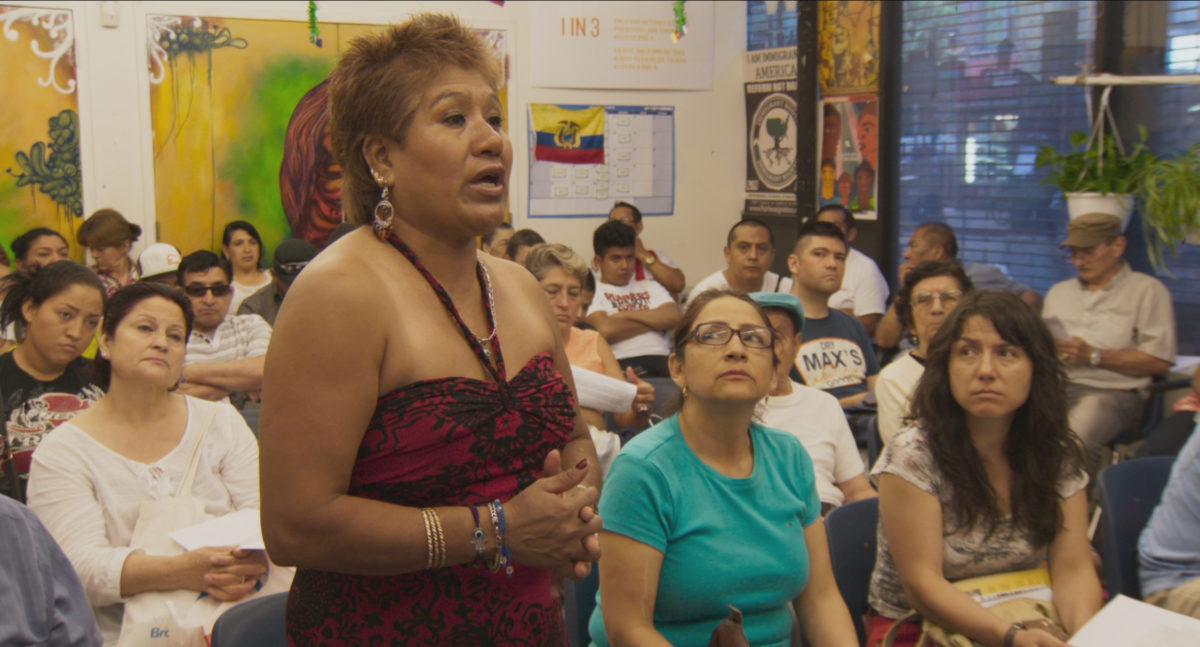The enigmatic titles of In Jackson Heights (Frederick Wiseman, 2015) and Austerlitz (Sergei Loznitsa, 2016), both playing at this year’s Film Fest Gent, saw me entering auditoriums loaded with remote and intangible expectations. I had an idea that Jackson Heights was a neighborhood somewhere in the U.S., and I (very mistakenly) took Austerlitz to be the name of Auschwitz in some Eastern-European language. Expectations were unraveled in either case, as the 3-hour runtime of Jackson had me expecting the type of film that Austerlitz turned out to be. Meanwhile, Austerlitz lacked the pointed, obvious tourist-criticism I’d expected; its exact intentions remain unclear, seemingly to purposeful extent.

Austerlitz features hordes of tourists mulling around a concentration camp in static black and white long takes. The ultimate ‘message’ is simple observation: it is useful to observe a Nazi concentration camp, recognize its significance. What can be done beyond that? We can hardly criticize the tourists mulling about, yet it is impossible to ignore the irony of crowds so eager to enter this location en masse which so many were once forced into, not to mention the insane irony of an endless parade of T-shirts adorned with slogans, brands and locations (i.e. NYC, PARIS, JURASSIC PARK, DOPE, BATMAN, MUSIC IS MY LIFE, JUST DON’T CARE, COOL STORY BRO, F**KIN 99 PROBLEMS) among which ‘ARBEIT MACHT FREI’ settles comfortably as another harmless catch phrase. While there is certainly something wildly obscene – even surreal – about a family posing for a selfie-stick portrait in front of the aforementioned sign, Austerlitz seems to note it less as a conviction of guilt and more as an unfortunate result of the new habits instilled in us by easier and constant access to contemporary technologies. For the most part, our subjects are ordinary people trying to figure out how to conduct a performance that conveys their comprehension of the incomprehensible. Yet for every person seemingly deep in thought – or at least aiming to show enough respect as to seem deep in thought – there is a counterpoint. An old woman watches a young girl skip back and forth across the hall with disdain. One man walks into a room with a GoPro camera on a stick, intent on documenting the whole of the room, from various angles while moving as little as possible. It is the paradox of tourism as sport: working hard to lazily seek out what has been prepared and readymade. But why does he film it? Surely he doesn’t believe himself an important archivist of the history of the holocaust? Is it some indicator of the senseless accumulation of overabundant personal material instilled in him by capitalism? Why do we film him? Out of some misguided desire to criticize his behavior and feel better about ourselves? They are clearly different documentary impulses, for different audiences, but both captured by people.

While director Sergei Loznitsa holds no overt control over the subjects who meander in and out of frame, each image is carefully composed. A film like this ends up being to some degree about the passage of time, regardless of how centrally it hones in on it (or doesn’t), and one shot in particular spoke to me as a visualization of time: looking through a building via windows. Directly in front of the camera is a window with the reflections of things behind the camera in physical space. Through the window and inside the room is another window to a mostly empty outdoor space with a building that recedes into the skyline. In the middle ground of the room between the windows, tourists walk in and out of the present moment. On either side of them lie the past and future. The beauty of the shot lies in its comprehension of time; the past and present exist simultaneously in any direction around us. The people reflected on the window might be ghosts of camp or projections of where those inside the room might soon find themselves. The building outside is framed by history, or a restrictive view because of our inability to accurately visualize the future.
In Jackson Heights as a focus on location deals more directly with the people who live there, because they are not tourists but permanent residents. How do you communicate a location? Director Frederick Wiseman does so primarily through examining not just its people, but also the neighborhood they’ve built from numerous communities. Through its duration, Wiseman throws in everything but the kitchen sink, or gives the impression of such, until we return to certain group meetings and familiar faces over time. In Austerlitz, too, many tourists make surprising and repeat appearances, a simple tool to lend either film a much stranger sense of cohesion. Films, as collections of moments, often leave stronger impressions from these small moments than from the whole. In Austerlitz, each shot is relatively similar to those before and after it in terms of duration, content, etc. The moments retained come from our own picking and choosing as audience members.
In most cases the frame envelopes the whole of a cosmos of moments. In Jackson Heights’ construction is more variant (although it’s endowed with a highly deliberate sense of flow): long scenes of monologues and dialogues in meetings peppered with short sequences comprised of more frequent cuts, centered around events and objects: trams, trains, shops, rallies. We witness the planning of an LGBTQ rally, and significantly later, the rally itself. Then the accompanying police brutality at another rally, and the civilians filming it purposefully. A backroom slaughtering of chickens in a restaurant advertising ‘LIVE CHICKENS’ comes across so matter-of-factly that the sequence’s inclusion reads in a tone something like “I just thought you might like to know.” Wiseman doesn’t seem intent on a grand political message though: merely to show us the community and what they’re invested in. They just happen to have a large amount of political interest.

Two moments nearly brought me to tears. One was a boy on the sidelines of police brutality. He is wheelchair bound, expression effectively blank. The other was of an older woman who sounded like she could’ve been from my home state ‘teaching’ a handful of fresh U.S. immigrants in preparation for their citizenship test. It’s relatively clear that the participants don’t entirely understand what they’re being asked and instead mostly parrot back what they are being told. When asked “what are you gonna say when they ask why you want to live in the U.S.A.?” an Indian woman begins, “Freedom of speech, freedom of the pre—”
“No, that’s the Bill of Rights,” as if it weren’t a valid answer to her question. It is the very kind of homebred thinking which produces the very issues our protagonists’ activist groups find themselves up against. What’s lost in translation between them is heartbreaking. What is this moment? The truth of performance. Much like our Austerlitz tourists, everyone is just trying to understand, and to share that understanding.